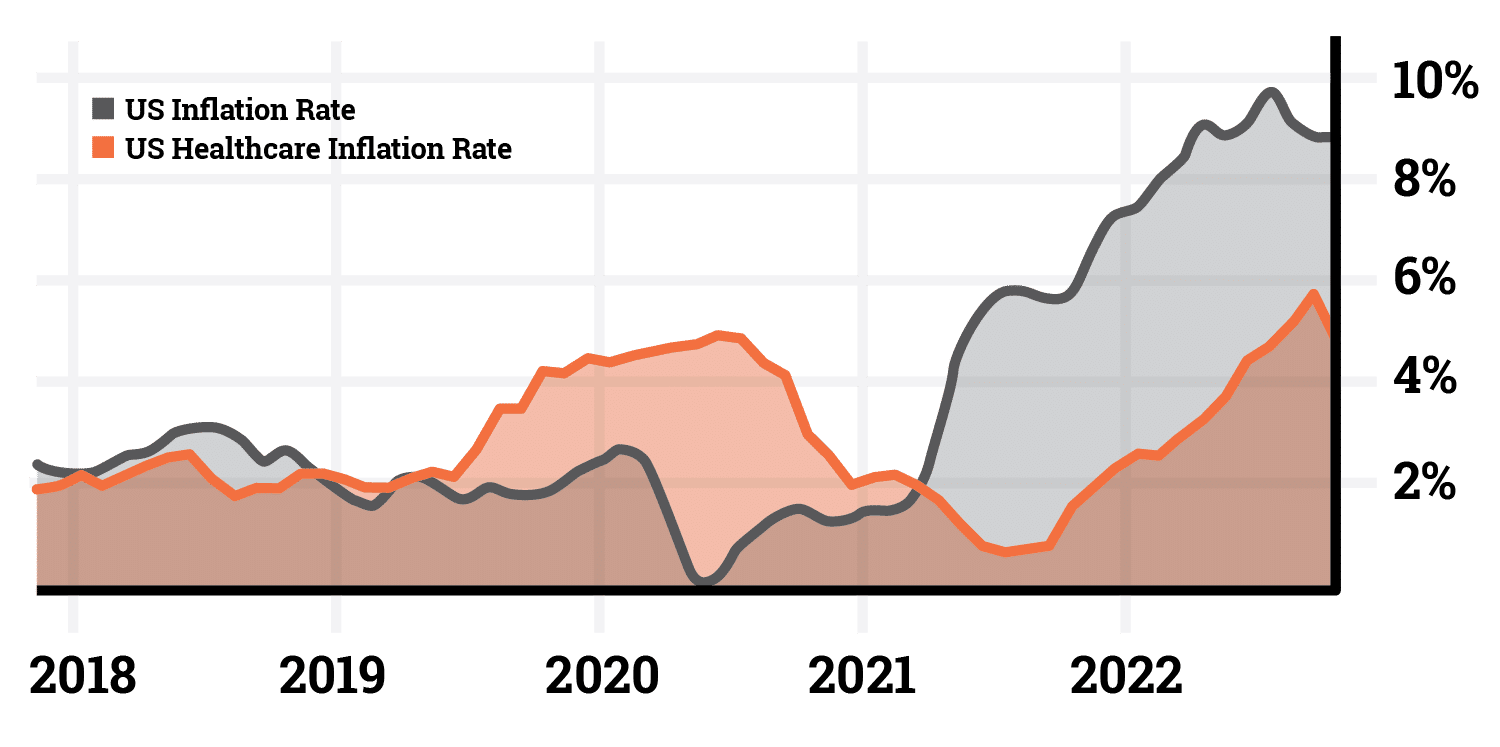What Is Cost Containment in Healthcare?

What is cost containment in healthcare? It’s a question employers are asking more urgently as they search for ways to save money and cut spending while healthcare prices continue to skyrocket.
Healthcare spending has grown out of control. In fact, the United States currently spends more than three times as much as other high-income countries. Even with spending projected to return to pre-pandemic levels, the rate at which prices have been increasing is becoming unsustainable for many employers and their operations.
The problem with cutting spending on healthcare is that it can result in providing employees with diluted forms of healthcare coverage. Even the most frugal employers recognize the value of providing comprehensive healthcare. Whether it’s attracting new talent, retaining quality employees, or ensuring the workforce remains healthy, happy, and productive, high quality healthcare benefits continue to be a leading factor in fostering productive labor.
Thankfully, employers can choose from various practices designed to reduce healthcare spending and control costs, often without sacrificing the level of care afforded to employees. These practices are described as cost containment measures.
What Is Cost Containment in Healthcare?
Cost containment in healthcare refers to a series of management procedures that culminate in a comprehensive strategy to reduce company spending on healthcare. Such strategies have evolved as action items that contribute to the overall goal of minimizing administrative costs as healthcare spending becomes increasingly difficult to justify over time.
While employer spending has grown across most sectors, per-employee spending with private health insurance companies has grown the most over the last ten years.
U.S. Inflation Rate vs. Private Insurance Spending Per Enrollee Growth

Although U.S. inflation rates have seen significant increases in recent years, the growth of private insurance spending far outpaces that of inflation.
Cost containment strategies are designed to help contain the cost of healthcare expenditures with a combination of non-traditional healthcare models and payment integrity practices. Cost containment can come in forms like alternative reimbursement plans, changing a company’s health culture, and accessing care outside traditional provider and insurance networks.
Why Is Cost Containment Important?
Access to reliable and effective healthcare has never been more important, especially for employers. Happy employees will always be more productive and few things contribute to employee satisfaction like the guarantee of good health.

Beyond that, cost containment has the potential to elevate the level of employee healthcare by removing many of the barriers to quality services.
Take, for example, a patient who needs a higher caliber surgery performed by a provider outside their network or struggles to find reliable in-network care. In this scenario, the patient’s out-of-network surgery would forfeit network discounts that are baked into private health insurance for employers and employees.
By implementing an effective cost containment strategy, the patient in this example would still be able to have the surgery performed at a fair rate without worrying about remaining within their provider network.
Why Is Healthcare Becoming So Expensive?
An array of factors—from multiple sources, over many years—contribute to the sharp incline in healthcare costs and healthcare spending.
- Medical providers are paid by quantity, not quality. Because the majority of insurers pay healthcare providers under what is called a fee-for-service reimbursement model, they receive payments for every single visit or procedure. A problem inherent to the fee-for-service model is that it incentivizes providers to prioritize volume, which often results in rushed visits with doctors trying to see as many patients per day as possible. This approach obviously puts a strain on providers, and it deprives patients of the kind of quality care that prevents unnecessary repeat visits.Providers under this model do not profit from healthy patients. Instead, they benefit from repeat visits to physicians, specialists, and general overtreatment—because hospitals are still profit-driven corporations, even if they label themselves as non-profit.
- Lack of pricing transparency. Unlike most other industries, medical providers don’t typically advertise the prices of their services. If you can imagine buying a new car without knowing how much it costs, it’s a fairly close comparison to how medical services work, even when some procedures cost more than the average family sedan.Spelled out like this, the entire system may seem silly, but this is how we’ve been paying for healthcare for decades. The vast majority of patients are unaware of final amounts due on medical services before they receive them. This lack of transparency allows providers to markup charges far beyond what procedures might actually cost.
Even in rare instances when hospitals do provide estimates, the costs are often obfuscated by complex medical codes that make them difficult for the average person to understand.
This hasn’t gone unnoticed by our government. While healthcare-related legislation has proved difficult to pass, Congress has been able to pass legislature such as the No Surprises Act in 2022 in an attempt to mitigate the effects that the lack of transparency in medical pricing has had on healthcare costs.
- Industry consolidation. While companies are quick to claim that mergers and purchases will result in lower costs for customers, this is rarely the case. A recent study by the Department of Economics at Northwestern University supports earlier research published by The Journal of the Missouri State Medical Association; both studies suggest mergers tend to coincide with increased healthcare costs and also fail to improve quality. This makes them a net negative for patients.These statistics may not be surprising, but they become more alarming upon learning that the healthcare industry is one of the current hotbeds for industry consolidation. In short, mergers and acquisitions are excellent at making corporate leaders a lot of money, but they often harm patients by hiking prices and driving down the quality of healthcare.
- Inflation. Inflation hasn’t just increased the prices of food, rent, and gasoline—it’s affected healthcare pricing as well. Inflation drives up the costs of supplies and administration for medical providers. While healthcare inflation has not yet outpaced general inflation, the trajectory of rising costs nearly mirrors the rate of inflation.
U.S. Inflation Rate vs. U.S. Healthcare Inflation Rate

While U.S. inflation rates continue to bloat prices across the board, National Health Expenditure data compiled by the Centers for Medicare and Medicaid Services (CMS) project health spending to increase by 5.4% annually through 2028.
What Are the Best Cost Containment Strategies in Healthcare?
Now that the question “what is cost containment in healthcare?” has been answered, you may want to know more about the practices that make up a cost containment strategy. Some of the best cost containment strategies include:
- Self-funded healthcare plans
- Bundled payments
- Payment integrity measures
- Efficient use of managed care plans
- Telemedicine/Telehealth options
- Cultural changes to support wellbeing
Self-funded Healthcare Plans
With traditional private health insurance plans, the insurance company pays for medical bills and then expects to be reimbursed by employers and employees at a fair rate. In contrast, self-funded healthcare plans pay medical providers directly, without a middleman.
This may sound more expensive at first glance. However, insurance companies often overpay for care because they stand to profit regardless. Most insurance plans pass on their expenditures to patients and employers as premiums, copays, coinsurance, and deductibles—for which the insurance company sets all pricing.

The best self-funded solutions, like a reference-based pricing model, use widely accepted reference points and benchmarks in a pre-payment strategy to negotiate fair and reasonable medical payments. This approach produces huge savings for employers and eliminates traditional health insurance fees from the equation.
Bundled Payments
Providers often bill patients for the individual medical services included as part of a larger procedure. For example, if a patient has a common surgery performed on their anterior cruciate ligament (ACL), each individual service—anesthesia, sterile supplies, medication—will have a corresponding charge on the bill. Bundled payments have become more popular because they offer patients a lump sum payment for all services included in a treatment plan.
Payment Integrity
Payment integrity aims to cut to one of the core problems of outrageous medical costs: inaccurate charges—due to egregious billing practices or genuine mistakes. Billing errors are extremely common in the healthcare industry and can result in thousands of wasted dollars on unnecessary or duplicate charges. This issue is compounded by the fact that providers almost always bill for medical services after the service has been rendered.
Payment integrity solutions such as clean claim reviews evaluate every line item on a bill to ensure the accuracy of all charges and that no payments are remitted to the wrong parties.
Managed Care Plans
While still within the realm of private health insurance, prioritizing specific managed care plans where they make sense can go a long way toward keeping costs down.
For example, with younger employees in good health, encouraging them to enroll in health maintenance organization (HMO) plans that have much lower premiums and no deductibles, compared to preferred provider organizations (PPOs), could save employers and patients a lot of money.
Telemedicine/Telehealth
Telemedicine, often referred to as Telehealth, can bring down healthcare expenditures by enabling patients to substitute online office visits for in-person visits. If an in-person visit isn’t necessary (or possible), patients can still receive one-on-one time with their physician or specialist.
Virtual visits are less expensive than taking a trip to the doctor’s office and more convenient if patients don’t have to worry about taking time off work or leaving the house.
Cultural Changes
Establishing a healthy culture can help prevent your employees from needing medical care in the first place. Incentivizing employees to remain committed to healthy lifestyles, avoid unhealthy habits like alcohol and tobacco, and maintain a healthy diet keeps employees healthy and facilitates a positive work environment.
Employers can reinforce this culture of wellness by keeping healthy snack options and soft drink alternatives stocked instead of junk food and sodas, providing access to an on- or off-site gym, and company events like marathons. Implementing these cultural changes can also provide added benefits like increased employee morale and team-building.
Where To Start With Cost Containment in Healthcare
As you can see, cost containment in healthcare has benefits beyond simply lowering prices. It increases overall transparency in the healthcare industry and can also improve access to quality treatment options.
The best cost containment strategies use a variety of practices in combination with one another. For example, if you’re content with your current insurance plan but you want something to cover larger expenses or fill gaps in coverage, you don’t need to replace your entire network. Wrapping individual solutions like reference-based pricing around a managed care plan can still help reduce costs. Because no company is exactly the same, your cost containment strategy will depend on your organization’s unique situation.
Start Your Cost Containment Strategy With 6 Degrees Health
Once you’ve decided to incorporate cost containment into your organization’s healthcare plan, the next step is knowing where to start. To craft the most effective cost containment strategy, you’ll want to partner with industry experts who have a proven track record of providing cost containment solutions to control healthcare costs. That’s the 6 Degrees Health difference.
What is cost containment in healthcare? To receive more information on how 6 Degrees Health can spearhead your cost containment strategy, speak to one of our experts today to learn how cost containment can help you realize the true benefit of healthcare.
Looking To Lower Your Company Healthcare Coverage Cost?
As a service-first cost containment company, 6 Degrees Health is here to help employers and employees navigate a historically opaque healthcare system to pay only what is fair.



